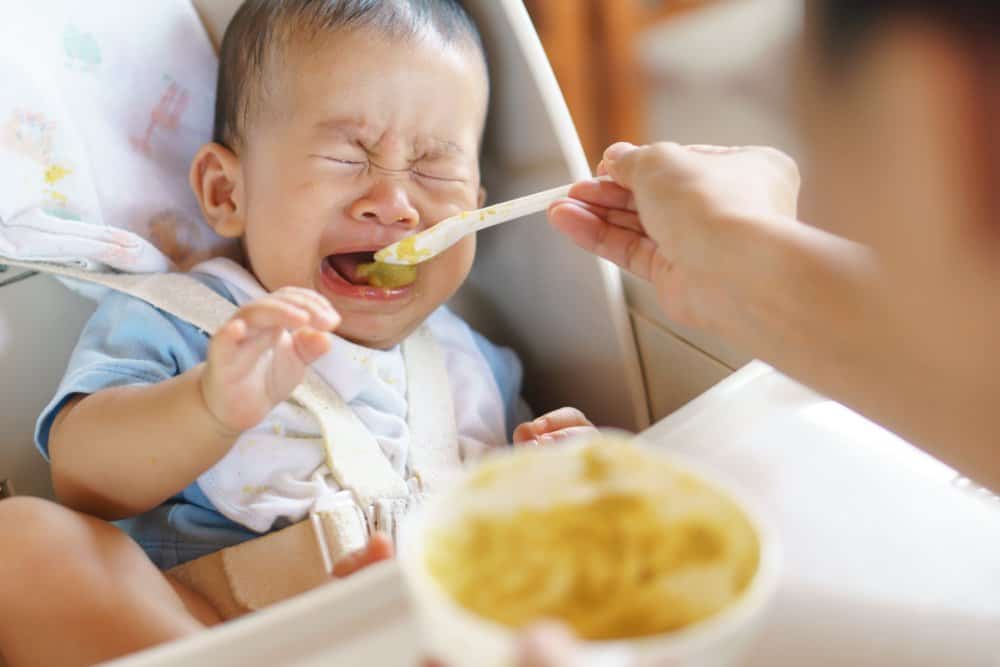Watching your child grow is one of life’s beautiful gifts. While people like to focus on the good, it’s not always easy. Raising a child takes a lot of effort, passion, and patience, and there’s no better example of the hard work parenting requires than the process of introducing solid foods.
So, where do you start? You’ve probably read countless articles and heard advice from everyone around you. Still, choosing a baby’s first foods can be overwhelming. We’re here to clear everything up and make the transition from breastfeeding or bottle feeding to solid foods straightforward. Read on to learn more about how to approach your baby’s first foods.
When are Solid Foods Introduced?
Introducing solid foods is a big step for you and your child. The American Academy of Pediatrics recommends starting solid foods between 4-6 months. Still, many parents jump the gun, so you want to make sure you’re not rushing the process. Luckily, there are a few ways to know whether or not your child is ready to start eating solid foods.
Your Child Has Good Head Control
We’ll start with head control because it’s easy to notice. Newborns have trouble keeping their heads up. It’s adorable and hilarious to watch at times, but it’s also an important indicator of your baby’s development. This is why nurses and doctors focus on teaching you the best methods to hold and feed your child. Breastfeeding or bottle-feeding, you have to properly hold a newborn’s head up until.
Once your child can hold their head up on their own, they’re almost ready for solid foods. A great way to determine if your child can hold their head up is to sit them down in a high chair or booster seat. Carefully observe their head control. If their head is still, they’re ready, but if they’re struggling, you’ll want to hold off on those first foods.
Your Child Is Teething
Teething is a great way to determine whether a baby is ready for their first solid meal. Teething begins between 4-10 months. It’s the process in which your child’s first set of teeth start to grow in. The teeth push through the gums and become visible. While it can be a painful process for both parents and babies, it’s a sign that your child is almost ready for solid foods.
There are a few symptoms that indicate your child is teething. Some common symptoms include excessive drooling, restless sleeping, and refusal of food. For this reason, we recommend holding off on solid foods that require a lot of chewing until their teeth have penetrated their gums.
Your Child Opens Their Mouth When Food Is Offered
We all know how fussy children can be when it’s time to eat. Sometimes they’ll just sit there, staring at you as you try to get a spoon in their mouth. You might think they’re just being a nuisance, but this is their way of showing you it’s not time for solid foods or spoon-feeding yet.
This means you’ll probably need to practice some trial and error. Sit your child down in their high chair or booster seat and pay close attention to their body language. If they look stressed and keep their mouth closed, you’ll want to hold off on solid foods. On the other hand, if they’re playful and open their mouth, it will probably be an easy transition to solid foods.
Moving Food Within Their Mouth
Another factor to look for is whether or not your child can move food around in their mouth. This seems trivial because it comes naturally to adults, but babies have to develop tongue reflexes to accomplish this. If you feed your child solid foods and it rolls out of their mouth, you’ll want to hold off for a little while. We recommend waiting another week or two.
Keep in mind; these are rough estimates. Every child is different, so make sure you use your instincts before diving into solid foods. It’s always better to wait a few weeks instead of forcing the issue. Trust your instincts as a parent for when to persist and when to back off.
Starting a Baby With Solids
While you can start solid foods between 4-6 months, you’ll want to use solid foods as a supplement at first. The good news is that you probably have your breastfeeding or bottle-feeding routine down to a science by now. At this stage of the game, solid foods are all about teaching your child how to chew and swallow, so don’t worry too much about nutrition.
To get started, introduce solid foods during feeding times. If you feed your child milk or formula in the morning, try to make them eat solid foods first. Then, see how much formula or milk they need after.
Eventually, solid foods become fun for your child. Who doesn’t love a tasty snack, right? This commonly occurs between six and nine months. Once you notice your child is visually excited for their meals, it’s time to start a routine. This means you can start feeding them solid foods for breakfast, lunch, and dinner.
Feeding Your Child
Knowing when and how to introduce your baby’s first foods is great, but learning to feed them can be challenging. Many parents begin with spoon-feeding, which teaches children to use their mouths and pull food from the spoon. This is what we recommend starting with between 4-6 months.
Spoon-feeding is fun and straightforward. Scoop some food out of your baby’s favorite food jar and bring it towards their mouth. Instead of forcing the spoon in, let your child open their mouth, and guide it in. Monitor closely as they chew and make sure they swallow without choking.
Once your child reaches the 6-9-month mark, you’ll want to let them take control. If possible, have them hold a baby spoon and practice eating food on their own. This is going to be messy, so make sure you have a bib or burp cloth handy. If you notice that your child is struggling to eat independently, simply go back to spoon-feeding for another week before letting them try again. Babies can get frustrated, just like us, and it could make the process more difficult.

Choosing the Best Baby Food by Age
There is a lot of food that you can introduce to your child. Furthermore, as your child grows older, their nutrition needs change. There is a lot of food that you can introduce, so we’re going to take you through the best first foods to introduce based on the age of your child.
4-6 Months
When your child is 4-6 months, they’re going through a lot of changes. From teething to holding up their heads, they’re starting to perform foundational development tasks. While you might be tempted to introduce a wide variety of foods at this age, we recommend starting with baby rice cereal. You should also mix the cereal with formula or breastmilk to make sure your little one is getting plenty of nutrition and make the cereal easier to eat.
Rice cereal is a great source of zinc and iron. These are nutrients that your child needs, but breastmilk loses iron around this point as a mother’s body goes back to its pre-pregnancy state. While you’ll still need to breastfeed or give your child formula each day, they’ll need to get their zinc and iron elsewhere.
Rice cereal is a great supplement, but you should only use it as needed. Because of the elevated levels of arsenic rice contains, you don’t want to feed this to a young child more than three or four times a day. The FDA recommends keeping arsenic levels in the blood below 100 parts per billion. Baby rice cereal used to be close to this number, but improvements have been made to meet FDA guidelines, so as long as you’re not only feeding rice cereal, your baby will be fine.
6-8 Months
Once your child gets used to eating solid foods and moving them around their mouth, it’s time to widen their variety. If you only feed your child the same thing each day, they can’t develop a taste for anything else. So, once your child is comfortable, you can start introducing fruits, vegetables, and meats.
When introducing these foods, make sure the food is pureed. This makes it easier for babies to chew and swallow the food, decreasing the risk of choking. At this stage, you can experiment with a lot of different foods. Whether or not you want to introduce chicken and broccoli is entirely up to you; just make sure everything is small enough to be swallowed after a few bites.
9-12 Months
Once your child reaches the nine-month mark, it’s time to wean them off pureed foods. Instead of smooth textures, introduce your child to foods like mashed potatoes, cottage cheese, mashed banana, and shredded chicken. While the food will take them longer to eat, it will teach them the necessary skills to handle eating adult foods.
Best First Foods for Baby
Many parents wonder exactly what to feed their baby when just starting with food. At early stages, everything should be pureed and soft, the consistency of store-bought baby foods. While many parents choose to purchase store-bought baby food, there are a wide variety of options for your child. Below is a list of ideas:
- Baby Cereal
- Grains like oatmeal and rice
- Mashed apples and pears
- Mashed sweet potato or potato
- Squash
- Pureed well-done meats
While an increasing amount of your baby’s nutrition will come from solid foods, be aware of the fact that your baby will get most of their nutrition from formula or breast milk until about age 1.
A Note on Meat
While breastfeeding has some noted benefits, natural milk does sometimes require special attention to make sure your baby is getting the proper nutrients. If you’re only breastfeeding, ask your pediatrician about an earlier start for pureed cooked meats, as they have large quantities of zinc and iron that can help supplement milk.
Foods to Avoid
We want you to experiment with a lot of food, but there are a few foods that you need to avoid. Until your child is at least one year old, keep them away from traditional cow milk, honey, and popcorn. These foods can lead to digestive problems in your child.
You should also avoid any foods that are giving your little one trouble. Mealtime should be fun, so make sure they’re not making a fuss. Unfortunately, babies can be picky, so do some experimenting to see what works.
Introducing Finger Foods
One of the best parts of feeding babies is watching them discover finger foods. Finger foods challenge your child because they require skill to eat, which is vital for their development. Babies are also curious and playful, so they’ll want to get their hands on anything they can.
Still, you need to be careful with finger foods. You can introduce them before your child is a year old, but you need to do so carefully. For example, you’ll want to shy away from processed meats, baby hot dogs, meat chunks, large vegetables, and various types of nuts. These foods can cause your child to choke or develop digestive problems if consumed too early.
Focus on foods that can be cut into small pieces. Some great examples include banana slices, pieces of cookies, eggs, wafers, crackers, cereals like Cheerios, shredded chicken, and potatoes. The key to introducing finger foods is variety. Instead of focusing on one food your child likes, introduce your child to a wide pallet of foods that offer different nutritional components.
While finger foods offer nutritional value, babies still need to get most of their nutrition from baby foods. Growing children get nutrients from different sources than adults, so make sure finger foods are supplements and not the main course.
Keep an Eye on Food Allergies
Food allergies are scary, especially if they run in your family. While this might cause you to hold off on certain foods, that doesn’t mean you should keep them away from your baby. According to the American Academy of Pediatrics, it can be beneficial to introduce your child to potential allergen foods around 4-6 months.
The study showed that introducing peanuts to infants between 4-6 can prevent food allergies from happening. This includes allergies like peanuts, eggs, milk, eczema, and celiac disease. Still, sometimes allergies happen, so we want you to be prepared.
Traditional Food Allergies
If you feed your child a new food and notice an adverse reaction, there is a good chance they have a food allergy. Food allergy symptoms vary, but the most common symptoms include rashes, vomiting, loose stool, and swelling of the face. Here is a look at some of the most common foods known to cause allergies:
- Milk
- Soy
- Wheat
- Walnuts
- Pine nuts
- Almonds
- Pecans
- Eggs
These foods are responsible for 90% of all food allergies. As every child is different, when introducing foods for the first time, always pay close attention and monitor your child.
Lactose Intolerance
Lactose intolerance is a condition that makes it difficult for people to digest milk-based products like cheese. Lactose intolerance is uncommon in babies. This is a condition that usually develops as babies get older (typically gradually from 1-3 years)
If your child is showing signs of lactose intolerance, there is a good chance that it’s a reaction to something else. Instead of keeping animal products out of their diet and moving on, it’s a good idea to contact your doctor to see what’s actually happening.
Celiac Disease
You should also be on the lookout for signs of celiac disease. Celiac Disease affects 1 in 100 people across the globe. This is a disease that makes it difficult for the body to digest and process gluten. Gluten is commonly found in grains like wheat. While celiac disease is uncommon for infants, it’s still possible. Symptoms include rashes, fever, headache, loose stool, constipation, and fussiness after feeding.

Changes to Expect When Introducing Different Foods
We know how alarming changes in your child can be. Seeing a different reaction to food or discolored stool can lead to panic and a trip to the doctor. For this reason, we’re going to take you through a few changes to expect when you begin introducing the first foods outside of formula.
Changes to Stool
One of the first things you’ll notice is a change in your child’s stool. When it comes time to change their diaper, you’ll be welcomed to a smelly and unpleasant surprise. As nasty as it may be, this is entirely normal. These changes happen because of sugars and fats present within solid foods.
Depending on what you feed your child, their stool will look and smell different. For example, vegetables like peas can turn your child’s stool green, while vegetables like beets can cause it to turn red. These foods will also bring about a stronger odor. Digestion will naturally reregulate as a child begins to eat mostly solid food
When to Contact Your Healthcare Provider
Changes in stool are standard, but there are a few things to look out for. What you need to look for is the structure of their stool. If your child’s stool is watery and doesn’t solidify after changing foods, it’s time to reach out to your doctor. Also, be on the lookout for skin rashes, lesions, swollen tongues, and other signs of allergic reactions.
Final Thoughts
Entering the world of solid foods is an exciting time. While you get to focus on new and exciting ways to feed your child, choosing the best foods for their health is easier said than done. For this reason, you need to select your baby’s first meals carefully.
As long as you change things up, are willing to adapt, and offer your baby a wide variety of food, your child will end up happy and healthy. Introducing new foods to your child’s diet is a fun experience for both you and your growing baby, so do your best to make sure it stays that way.
If you notice changes in your child’s mood, health, or behavior, always reach out to your healthcare provider. Even if it’s nothing, it’s better to be safe than sorry, especially when dealing with babies.
